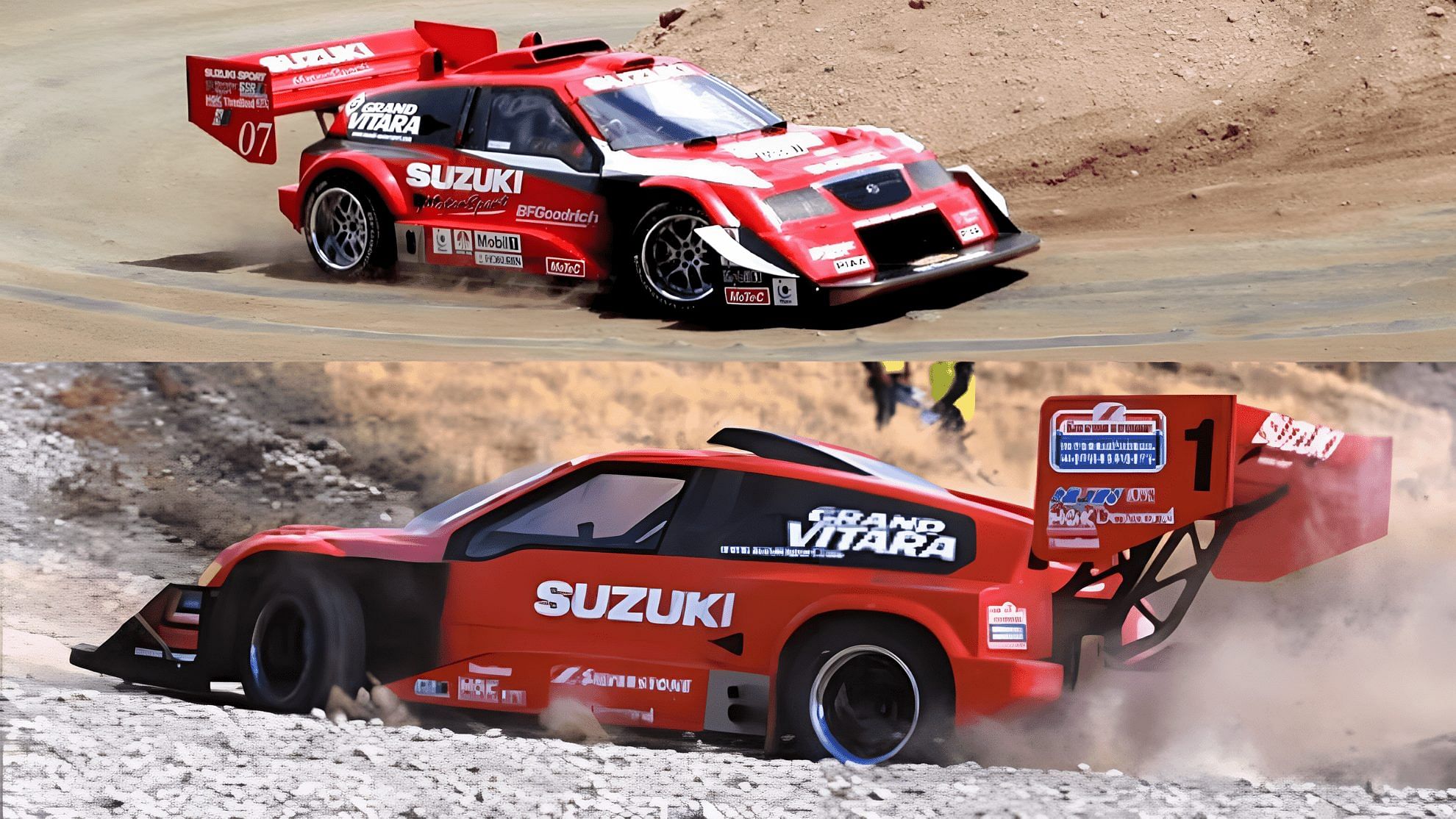How Gran Turismo Immortalized the Suzuki Escudo Pikes Peak
The Suzuki Escudo Pikes Peak achieved remarkable success in the iconic Pikes Peak hill climb race, but its fame was elevated to legendary status thanks to its inclusion in the Gran Turismo video game franchise. This virtual transformation allowed the Escudo to reach a wider audience and influence automotive culture.
Published April 8, 2024

The Suzuki Escudo Pikes Peak began as a highly-tuned off-road racer built to conquer the legendary Pikes Peak International Hill Climb. But it was the Escudos inclusion in the hit Gran Turismo video game series that truly cemented its reputation as one of the most iconic rally cars of all time. This compact monster with its massive rear wing transcended from pixelated legend to influencing real-world automotive culture. First introduced in Gran Turismo 2, this iconic vehicle has transcended the boundaries between the gaming world and reality.
In this article, we will explore the enduring legacy of the Suzuki Escudo Pikes Peak, delving into its real-life prowess, its pivotal role in the Gran Turismo franchise, and its profound influence on automotive culture. As we delve into the Suzuki Escudo Pikes Peak specs, it's clear that this car's prowess is not limited to the virtual world alone. You can also check the story of Jaguar Vision Gran Turismo Roadster making its debut on the Gran Turismo 7 Game.
The Real-Life Legacy: A Mountainous Triumph
The Broadmoor Pikes Peak International Hill Climb, a venerable motorsport tradition in Colorado Springs, presents a formidable challenge. Covering a grueling 12.42-mile course with 156 turns and an elevation gain of 4,720 feet, it demands nothing short of excellence. The Suzuki Pikes Peak Escudo, meticulously engineered for this very challenge, boasted a lightweight frame, a potent V6 engine, and an exceptional all-wheel-drive system, ensuring unwavering grip on Pikes Peak's treacherous terrain. In 1996, it set a record time of 10 minutes and 4.06 seconds, a benchmark that stood for 13 years. Behind the wheel, Nobuhiro Tajima's daring aero enhancements propelled the Escudo Pikes Peak to dominance, with its horsepower soaring past 1,000. Though retired from active racing, the Escudo's legacy endures, embodying the relentless spirit of motorsport.
The Escudo Pikes Peak in Gran Turismo: A Digital Phenomenon

The Escudo Pikes Peak's transition from the physical world to the virtual realm was nothing short of spectacular. Gran Turismo, a beloved video game series, played a pivotal role in elevating its reputation. Renowned for its exceptional speed and handling, the Escudo earned endearing monikers like "freak beast" in Gran Turismo 7. Featuring a turbocharged V6 engine, it boasted the unique ability to earn 1.7 million in-game credits per hour. Discussions about its in-game performance are commonplace, with numerous YouTube videos testing its speed and acceleration. Since its debut in Gran Turismo 2, the Escudo has become a cherished part of the series, participating in demanding races and challenges.
Authenticity Meets Virtuality
One of the key factors behind Pikes Peak Suzuki Escudo's virtual success is its fidelity to the real-world model. With its twin-turbo V6 engine producing over 1,000 hp, the in-game Escudo mirrors the authentic car's imposing presence. Players are captivated by its top speed exceeding 250 mph and the capacity to modify it to reach an astounding 1,900 hp. However, mastering its unique rear-engine oversteer handling requires skill and precision, adding to its iconic status. The wailing turbocharged engine sound further enhances the immersive gaming experience. Triumphant moments with the Pikes Peak Escudo have become a point of pride among Gran Turismo enthusiasts, solidifying its status as a legendary virtual race car that bridges the gap between virtual and real-world motorsport.
Fan Nostalgia: An Unexpected Transformation

The Suzuki Escudo Pikes Peak's meteoric rise in the gaming world was nothing short of a phenomenon. Unlocked in Gran Turismo 2, it dominated the virtual racing scene with its massive spoiler and nearly 1,000 horsepower, a remarkable transformation considering its origins as the Suzuki Vitara. Its appeal was a result of its unique design, over-the-top performance, and the formidable challenge it presented in the game. The Escudo's enduring relevance in Gran Turismo is showcased by its rendered interior and a Group 3 version of Suzuki's Vision Gran Turismo concept roadster.
A Legendary Icon
The Escudo's impact extends beyond the confines of Gran Turismo. It has left an indelible mark on other racing games, including Forza Horizon, solidifying its virtual legacy and iconic status. For fans, the Escudo Car symbolizes the early days of extreme racing games, evoking nostalgia and cherished memories of epic races, and pushing virtual cars to their limits. The Escudo Pikes Peak has transformed into a legend cherished by veteran racing enthusiasts, illustrating the enduring power of iconic virtual vehicles.
The Impact on Automotive Culture: A Catalyst for Change

The inclusion of the Suzuki Escudo Pikes Peak in Gran Turismo went beyond gaming. It provided invaluable insights to automotive manufacturers about consumer preferences in a virtual environment. This recognition in the racing industry was earned due to the car's virtual representation, showcasing its remarkable performance capabilities. It significantly impacted the automotive industry, highlighting the car's unique features and performance, and contributing to the industry's growth and development. The Escudo era also solidified Pikes Peak as a renowned hill climb event globally, thanks in part to legendary driver Nobuhiro "Monster" Tajima's association with the car. It showcased Suzuki's transition from off-road vehicles to high-performance racing machines and demonstrated the potential of radical aerodynamics.
Shaping the Future
The Escudo demonstrated the potential of transforming a small production car into a Pikes Peak racing contender, emphasizing advanced aerodynamics and turbocharged engine capabilities. Suzuki emerged as a daring and innovative brand like other Japanese automakers including Honda and Toyota and the Escudo played a pivotal role in the era of automotive video games shaping car culture. Its legacy endures, setting a benchmark for compact cars and electric vehicles taking on Pikes Peak, reflecting its profound influence on the automotive world.
Legacy and Future of the Suzuki Escudo Pikes Peak
The Suzuki Escudo Pikes Peak holds a special place in the hearts of gamers, particularly in Gran Turismo 2, where it is a highly sought-after car. Players fondly recall using the Escudo to conquer challenging races, such as the Rome 2-hour race in under two hours. Its popularity endures in Gran Turismo 7, where it remains a standout choice due to its performance and unique design, allowing players to earn significant credits.
A Continuing Saga: Path to the Future

Despite no longer racing, the Escudo remains an aspirational benchmark. As electric vehicles usher in a new era of Pikes Peak cult cars, Suzuki has the potential to leverage the Escudo's heritage to build future Pikes Peak racers or limited production road cars, with the fully paved Pikes Peak now etching its record times in history. Fans even clamor for a reinvented Escudo, possibly with a hybrid or electric power plant tuned for modern Pikes Peak conditions. The Suzuki Escudo Pikes Peak achieved notable recognition, the game's commitment to realism and attention to detail enabled players to genuinely appreciate the car's capabilities, sparking an increased interest in the actual vehicle. This virtual success also translated into real-world renown, firmly establishing the Suzuki Escudo Pikes Peak as a legendary racing car.
Write a comment
Comments
No Comments Yet









